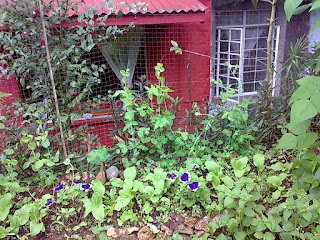This summer, I tried to practice companion planting by inter planting flowers and herbs in the vegetable garden. The bugs/insects will get attracted to the flowers and will leave the
vegetables alone, that is the idea in companion planting. Notice how I sowed my plants in the raised bed on the right side of the walkway in the picture above. French Marigold flowers were first planted around the edge of this raised bed and this was followed by two rows of Arugula greens and then two rows of Pak Choi, a leafy green vegetables with a thick white bottom. I often use Pak Choi in my cooking whenever I make stir-frys or in making soups. It's really delicious without the bitter taste that one usually gets in Pechay, another green leafy vegetable.

Even the small holes of the hollow blocks that were used in making the raised beds were planted with small grasses. The root system of these plants goes down deeply and it helps to hold the hollow blocks in place. In the photo above, you see the French Marigold flowers at the end of this raised bed. That brown triangle structure in the forefront is a home-made welded re-bar tomato cage with one tomato plant inside. In front of the tomato cages are Pack-Choi or Chinese cabbage. Behind this tomato cage is the Sweet Pea trellis. Anyway, to maximize the space and get more produce, I sowed Sweet Peas on both sides of this trellis. Planted next to the front and the back side of the Sweet Peas were lettuce of Lollo Rosso variety. Next to the lettuce facing the walkway, I sowed two rows of Carrots.

Notice the plants in the small plot under the Green Bean trellis? Those are the Lollo Rosso variety of lettuce that we often use when making a sandwich. I made a walkway around this small plot so I could go around it when I do some weeding on the raised beds. On the left side of the Green Bean trellis is a Zucchini plant.
This is the edge of the garden where I placed the arched trellis for
the Green Beans. When I removed the wire mesh fence around the old garden, I left the wire mesh on this side only so I could
grow some cucumbers and sweet peas on it. Since these two plants grow
in a vertical position, they could use the fence to climb onto as they
grow and they could be planted next to each other as well. I also added
some Pak-Choi and Petunia flowers in between the Cucumbers and the Sweet
Peas.


















































